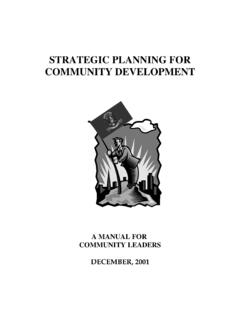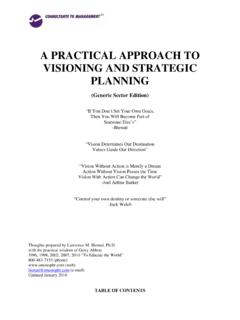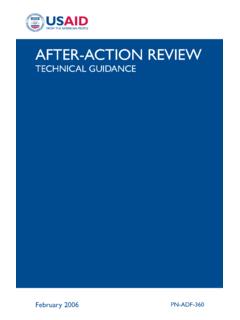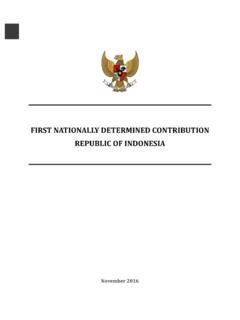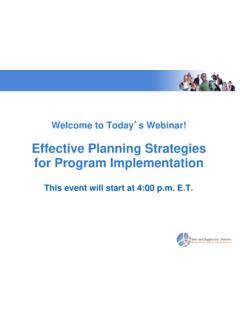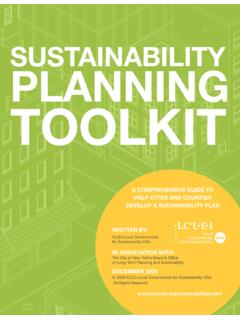Transcription of Better Criteria for Better Evaluation - OECD
1 Better Criteria for Better Evaluation Revised Evaluation Criteria Definitions and Principles for Use OECD/DAC Network on Development Evaluation 2 1. Background Rationale for adaptation 1. The Organisation for Economic Co-operation and Development (OECD) Development Assistance Committee (DAC) first laid out the Evaluation Criteria (relevance, effectiveness, efficiency, impact and sustainability) in the 1991 OECD DAC Principles for Evaluation of Development Assistance, and later defined the terms in the 2002 Glossary of Key Terms in Evaluation and Results Based Management. These five Criteria have come to serve as the core reference for evaluating international development and humanitarian projects, programmes and policies. Beyond development co-operation, evaluators and commissioners also use the Criteria in other areas of public policy.
2 2. Building from learning gathered over 25 years of applying the Criteria , the global Evaluation community began discussing revisiting the Criteria following the 2015 agreement of the 2030 Agenda for Sustainable Development, including the Sustainable Development Goals (the 2030 Agenda), and the Paris Agreement within the United Nations Framework Convention on Climate Change (Paris Agreement). In its High Level Communiqu of 31 October 2017, the OECD DAC decided to explore adapting the five key Evaluation Criteria to program evaluations in line with the 2030 Agenda . The DAC Network on Development Evaluation (EvalNet) the DAC subsidiary body responsible for supporting Evaluation and building the evidence base for policymaking and for learning pursued this adaptation in 2018-2019. 3.
3 The goal of the adaptation process was to take stock of lessons and experiences, in order to improve the Criteria . Better Criteria will support Better Evaluation . Better Evaluation will contribute to Better policies to advance the 2030 Agenda, achieve national contributions to the Paris Agreement, and other goals. Consultation on the Criteria : strengths and areas for improvement 4. The adaptation process included a far-reaching consultation, conducted May to November 2018, with a public survey, interviews, discussion at international meetings, and a review of literature. Based on initial drafts, consultations continued into late 2019. A summary of findings from the consultation is 5. The consultations found widespread support for and use of the Criteria .
4 Respondents clearly preferred to maintain the main body of the current set of Evaluation Criteria , recognising their universal acceptance and usefulness. Many respondents highlighted the value of the Criteria in bringing standardisation and consistency to the Evaluation profession and evaluative practice. It was also clear that there was a need for continued simplicity, by retaining a limited set of Evaluation Criteria and keeping the definitions coherent. 1 See DAC Network on Development Evaluation (2018), OECD DAC Evaluation Criteria : Summary of Consultation Responses (November 2018). Available at: 3 6. At the same time, requests were received for clarifications of certain concepts. Many pointed to challenges with the way the Criteria are applied in practice.
5 Particularly problematic is the tendency to cover too many Criteria and questions. While the Quality Standards for Development Evaluation are clear that the use of all the Criteria is not mandatory, and that other Criteria may be used, in practice they can end up being applied mechanistically without sufficient consideration of the Evaluation context and intended purpose. There was also concern that the original set of Criteria did not adequately encompass the 2030 Agenda narrative and current policy priorities. Some felt the Criteria were too project-focused and did not sufficiently address issues such as complexity and trade-offs, equity, and integration of human rights and gender equality. Many requested enhanced guidance on implementation of the Evaluation Criteria , to improve their use and to contribute to enhanced Evaluation quality.
6 7. In addition, the consultations brought to light a number of weaknesses in Evaluation practice and systems that go beyond the Criteria and their definitions. In line with its mandate to support Better Evaluation , EvalNet is committed to working with partners in the global Evaluation community to address these concerns, and is currently exploring options for additional work. Key features of the adapted Criteria 8. To respond to the request of the OECD DAC s High Level Communiqu , as well as to address findings from the consultation, EvalNet developed an adapted set of definitions and principles for the use of the Criteria . EvalNet members and partners commented on two drafts, and then a series of webinars were held permitting an in-depth exchange and interaction on the definitions.
7 International Evaluation experts were also invited to provide feedback on drafts. 9. Drawing on all of this input, the adapted Criteria have the following features: New and improved definitions of the original five Criteria : Preserving and enhancing the key strength of conceptual clarity, definitions were refined and notes used to explain the concepts, while keeping the text as short and simple as possible. Adding one major new criterion coherence to Better capture linkages, systems thinking, partnership dynamics, and complexity. Supporting use and addressing confusion by adding: an introduction on the intended purpose of the Criteria ; guiding principles for use; and an accompanying guidance to explain further the dimensions of each Criteria , and how they apply to different evaluations (forthcoming).
8 Ensuring applicability across diverse interventions, and beyond projects: Recognising the diverse range of development and humanitarian activities and instruments subject to Evaluation and the use of the Criteria beyond development co-operation the term intervention is used (rather than external funding, programme or project, as previously). References to donors have likewise been removed. Better responding to current policy priorities, including equity, gender equality, and the leave no-one behind agenda: The definitions of relevance and effectiveness in particular, encourage more in-depth analysis of equity issues. The Criteria are useful for evaluating efforts (whether national, sub-national or international) aimed at achieving the Sustainable Development Goals as set out 4 in the 2030 Agenda and the Paris Agreement.
9 At the same time, the Criteria are high-level enough to ensure they will be widely applicable, and will remain relevant as policy priorities and goals change. Reflecting the integrated nature of sustainable development, the definitions and guidance for use promote an interconnected approach to the Criteria , including examination of synergies and trade-offs. 5 2. Adapted Evaluation Criteria Purpose of the Evaluation Criteria 10. The purpose of the Evaluation Criteria is linked to the purpose of Evaluation . Namely, to enable the determination of the merit, worth or significance of an The term intervention is used throughout this document to mean the subject of the Evaluation (see Box 1). Each criterion is a different lens or perspective through which the intervention can be viewed.
10 Together, they provide a more comprehensive picture of the intervention, the process of implementation, and the results. 11. The Criteria play a normative role. Together they describe the desired attributes of interventions: all interventions should be relevant to the context, coherent with other interventions, achieve their objectives, deliver results in an efficient way, and have positive impacts that last. 12. The Criteria are used in Evaluation to: Support accountability, including the provision of information to the public; Support learning, through generating and feeding back findings and lessons. 13. The Criteria are also used beyond Evaluation for monitoring and results management, and for strategic planning and intervention design. 14. They can be used to look at processes (how change happens) as well as results (what changed).











